
23 minute read
Hit the Road
Hit the Road!
Advertisement
SHORT TRIPS CAN LIFT YOUR SPIRITS AND GIVE YOU NEW PERSPECTIVE. BY JEANNE O’BRIEN COFFEY
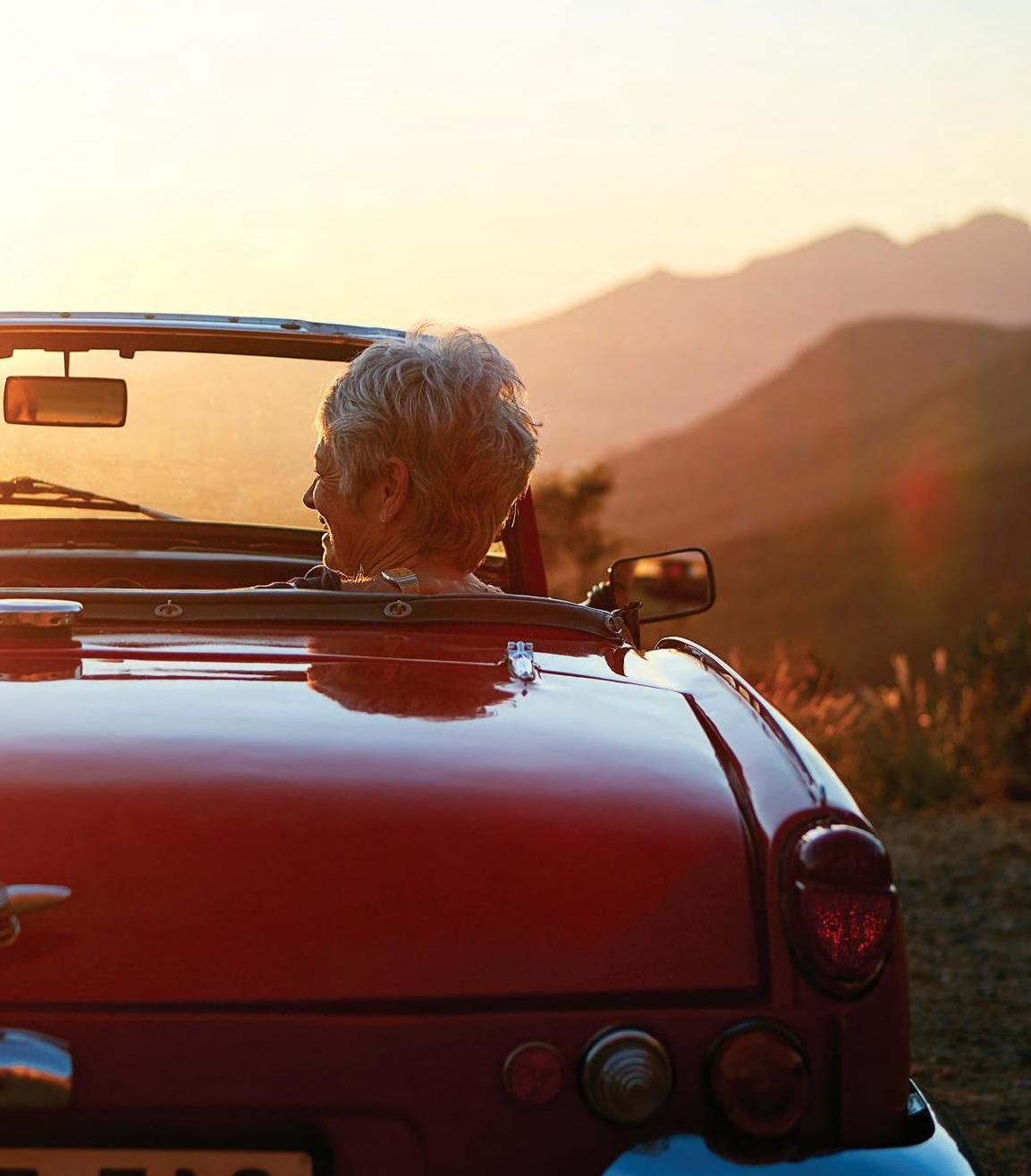
After more than a year of being cooped up, a change of scenery—even a stroll in a park a few towns away—can do wonders for your health, both mental and physical. “Day trips are a great idea, especially if you’re spending time outside. Sunshine and fresh air are so good for the mood,” says Kumar Dharmarajan, MD, MBA, cardiologist, geriatrician, and Chief Scientific Officer at Clover Health. Whether you’re headed out to see much-missed family, taking a leisurely drive, or visiting the beach, experts say planning ahead will go a long way toward keeping you safe. Take it slow, be prepared, and don’t forget to pack plenty of patience and positivity! Ready to venture forth? Follow these six tips to help your outing go smoothly.
1DINE SMART Currently, the CDC says eating indoors is still risky business. To minimize exposure, opt for open-air dining or grab takeout. A cooler full of sandwiches, prepared vegetables and fruits, and snacks lets you take advantage of a pretty spot along the way for an impromptu picnic.
Whenever possible, skip busy highway rest stops during peak times (around meals). Instead, plan your breaks for off-hours. To find restaurants with outdoor seating nearby, you might check online— opentable.com, yelp.com, or travel websites like trippy.com and roadfood.com.
2SLEEP SAFE Most major hotel chains, as well as Airbnb, have implemented new COVID-19 standards that may include things like leaving a room vacant for a few days between guests and hospital-grade disinfecting protocols.
Call ahead or visit the property’s website to check mask requirements, occupancy limits, and cleaning procedures. For added peace of mind, bring disinfecting wipes to clean surfaces and avoid crowded hotels. Pack zipper plastic storage bags, and drop the TV remote into one before channel surfing. (Those devices are notoriously hard to clean.) Remember to wash your hands thoroughly after you’ve given the room a sanitizing once-over.
Bring your own refillable coffee mug and water bottle for drinks, and avoid the ice bucket, advises Katia Harvie, who has traveled the world as an

Editors’ Note: Most readers who chose to be vaccinated will have received their vaccines by now. However, every person has different risk factors. For the best guidance for your specific situation and travel plans, as well as for those who have not been vaccinated, consult your physician or the Centers for Disease Control and Prevention (CDC) at bit.ly/CDCSafeTravel.

independent consultant working with major hotel chains to evaluate customer experiences.
“Common culprits for cleanliness violations are glassware, linens, and surfaces, but the most overlooked item is the ice bucket,” she says. “It rarely gets a deep clean; I have found dust on many occasions.”
3STAY CONNECTED Before you head out, use your smartphone to download directions to your destination— just in case you hit a cellphone service dead spot. Don’t forget to share your itinerary with family members and friends. 4 PACK RIGHT In addition to clothes and important medications, bring paper towels, toilet paper, and of course, plenty of masks, hand sanitizer, and disinfecting wipes. (Read the package to make sure you buy the kind that kills the COVID-19 virus.) A travel thermometer is another smart choice if you’re planning to be away more than a few days.
5SUN SMARTS Planning to spend time in the sun? Bring lightweight, loosefitting clothes and sunscreen that’s at least 30 SPF.
The Environmental Working Group, a nonprofit focused on protecting human health and the environment, recommends choosing sunscreen with the active ingredients zinc oxide and/or titanium dioxide, which form a physical barrier to protect your skin. Try to stay in the shade from noon to 4 p.m., when the sunlight is strongest.
Harmful UV rays can reflect off the sidewalk, grass, water, and other surfaces, so it’s important to wear sunscreen even in the shade. Our skin gets more fragile and vulnerable to the sun as we age—and certain medications

SCENIC DRIVES
For the first time in more than a decade, the Federal Highway Administration added 49 new routes to its America’s Byways® collection, which celebrates roads for their archeological, cultural, recreational, and scenic significance. There are more than 184 byways to explore in 48 states, including the Pine Barrens Byway in New Jersey, which offers both historic sites and natural beauty. There’s also historic Route 66, which rolls past iconic motels and restaurants from Illinois to California. Popular attractions may be subject to capacity limits or altered schedules. Arrive early or find out if you can reserve a slot in advance. To download the free list of America’s Byways Designations, go to: bit.ly/AmericasByways.

increase sun sensitivity. In fact, most skin cancers are found in people aged 65 and older. But fewer than half of seniors protect their skin from the sun when outside for an hour or more, according to the CDC.
Your risk of heat-related illness also increases after age 65, according to the CDC, so stay hydrated and be aware of the temperature and heat index (the combination of heat and humidity). Humidity makes it harder for sweat to evaporate, which means your body can’t cool itself as effectively.
6TRY A PODCAST With a free app (such as Apple Podcasts or Google Play), every smartphone can play podcasts—audio programs that you can listen to on the go.
HOW TO GET UPDATES ON TRAVEL RESTRICTIONS
n The Centers for Disease Control and Prevention (CDC)’s website provides links to state and local restrictions: bit.ly/CDCTravelPlanner. Search by city, state, or ZIP code. You can also call the CDC at 800-CDC-INFO (800-2324636) for answers to questions in English and Spanish, Monday to Friday from 8 a.m. to 8 p.m. EST. n The American Automobile Association (AAA) provides a free online COVID-19 Travel Restrictions Map that’s updated frequently with state-by-state mandates and information on confirmed cases: bit.ly/AAATravelRestrictions.
From current events to longform stories, there are more than half a million options available, so there is something for everyone.
Turn back the clock with Lux Radio Theatre, which features recordings from the golden age of wireless with stars like Clark Gable and Marlene Dietrich performing. Catch up on your historical knowledge with the Stuff You Missed in History Class podcast.
Or, if you’re bringing grandkids, try Eleanor Amplified, which follows the exploits of a reporter turned crime fighter. It’ll keep the whole family laughing.
But no matter how much fun you’re having, be sure to limit the number of hours you drive and take frequent breaks to avoid driving while tired. Enjoy the journey.





Before You Go: Trip Tips
PUBLIC TRANSIT If you rely on public transit, the CDC suggests traveling during nonpeak hours, when there are likely to be fewer people. Also, try to leave an empty row between groups where possible. Be sure to follow proper hand hygiene, and don’t eat on a bus or train. If you’re using Uber or taking a taxi, avoid shared rides with people who are not in your household, and don’t get into any vehicle where people are not masked. Ask for the windows to be open or air to be circulated from outside the car.

CARS If you’re driving, giving your car a once-over before hitting the road is just as important as getting directions. “Preventive maintenance is essential for safe driving and greatly decreases the chances of being stranded,” says Ellen Edmonds, a spokesperson for AAA, a membership and advocacy organization for drivers. Whether you do it yourself or go to a repair shop you trust, AAA recommends the following: ■ Diagnose any “check engine” light. ■ Test your battery, particularly if it’s more than three years old. ■ Replace windshield wiper blades that leave streaks or miss spots. ■ Check all fluids and brakes. ■ Inspect the tires. If there’s less than 4/32" of tread, you will have reduced traction in wet conditions. Check the tire pressure before driving, too, when tires are cold. CAR CHECKLIST In addition to keeping up on scheduled maintenance, AAA suggests stocking your car with these safety items: ■ Cellphone and car charger ■ Flashlight with extra batteries ■ Jumper cables or jump pack ■ Basic tool kit (screwdrivers, pliers, adjustable wrench, duct tape, plastic zip ties) ■ Tarp, raincoat, and gloves to help you stay clean and dry working on the roadside ■ Rags, paper towels, or premoistened wipes ■ Warning devices (flares, reflective triangles,
LED beacons) ■ First aid kit ■ Drinking water ■ Snacks for passengers and pets ■ Windshield-washer solvent

PHOTOGRAPHS: JOHNNY MILLER PROP STYLING: SARAH SMART FOOD STYLING: REBECCA JURKEVICH/EDGE REPS PHOTO EDITOR: SARAH ROZEN

Healthy, Easy, and Delicious Plus 4 gadgets that make cooking a breeze
BY SARAH COPELAND
IN A WORLD of faster, better, cheaper, it can be easy to get caught up in the dizzying promises of appliance makers touting healthier, better living with the push of a button. But is one more thing really the answer? Here are four made-for-better-living kitchen appliances that actually deliver healthier mealtimes, all while cutting down on the work.
Spiralizer
WHY TRY IT Want to eat more vegetables? Spiralize them! This simple device has fine blades that slice everything from squash and zucchini to sweet potatoes and beets into spaghetti-like strands. Called “zoodles,” spiralized veggies make a completely gluten-free, antioxidant-rich pasta fill-in or a crunchy topping for otherwise boring salads. A spiralizer also makes quick work of any vegetable surplus: Anyone with a robust home garden (or access to a community one) or commitment to a plantforward diet will find this modestly priced tool positively inspiralizing.
HOW TO BUY IT With prices ranging from $10 to $60+, from brands you already trust (OXO, Braun, KitchenAid), this is an easy add-on, even to a microkitchen. Opt for a hand-held, hand-cranked, or motorized stand-alone appliance or attachment to your food processor or stand mixer, depending on how much space you have.
White Pizza with Spiral-Cut Zucchini
You’ll find many recipes for spiral-cut salads, coleslaws, and zucchini noodle pastas online, but for a winning feel-good favorite, try adding spiral-cut vegetables to your favorite pizza. This one uses creamy, low-fat ricotta, basil, and fresh zucchini on a crispy, par-baked (partially prebaked) crust for an at-home California-style pizza night that pairs beautifully with a crisp Napa wine.
Mix up the toppings, depending on the season, by adding in fresh (or leftover)
charred corn, baby kale, or zucchini flowers.
Prep time: 10 minutes Cook time: 20 minutes Serves: 4 1 prepared, par-baked whole wheat (or glutenfree) pizza crust 1 small zucchini, spiralized ½ teaspoon fine sea salt ¾ to 1 cup fresh ricotta cheese ½ cup shredded mozzarella cheese 1 cup cherry or grape tomatoes, halved ¼ cup olives (black or green), pitted, optional Extra-virgin olive oil, for drizzling ½ cup fresh basil leaves
1 Preheat oven (with a pizza stone, if available) to 475 degrees F. Place the pizza crust on a baking sheet and set aside.
2 Toss the zucchini noodles with ½ teaspoon of salt and set aside to release any moisture. Layer the pizza crust with the ricotta cheese, using up to 1 cup if you like a creamier topping. Sprinkle evenly with mozzarella. Gather the zucchini spirals, letting any liquid drain off (draining onto a paper towel or through a sieve, if needed; younger, fresher zucchini will have more water). Scatter the zucchini spirals evenly over the ricotta. Add the tomatoes and olives, if using.
3 Bake until the pizza crust is golden brown and crispy, the mozzarella is melted, and the vegetables wilted and warm, 15 to 20 minutes. Drizzle with olive oil and scatter the fresh basil on top. Serve warm with a salad.
Instant Pot
WHY TRY IT This sealed pot with a valve to control steam cuts the work of preparing home-cooked meals in half— whether it’s homemade pasta sauce, vegetable-packed soups and stews, bone broth or stock, or morning porridges. Using pressure and steam to tenderize meats, instantly steam vegetables, or pressure cook good-for-you whole grains in less time is a win for those looking to eat more homemade, well-balanced meals at home more often. (Bonus: It cooks fish and shrimp in just minutes!) It also allows you to cut fat down considerably, since water or broth—aka steam (not oil!)—is the vehicle for succulence here. This one earns its keep.
HOW TO BUY IT Instant Pot’s 6-quart 7-in-1 is an ideal size when cooking for two. But numerous competitive brands make an equally user-friendly model, including All-Clad, Cuisinart, Wolf, and Ninja. Expect to pay between $50 and $200, depending on the bells and whistles you desire. Pro tip: Simpler models work just as well as more expensive ones.
Broccoli-Pea Summer Soup
Adapted from Instant Family Meals by Sarah Copeland (Clarkson Potter)
Who doesn’t love a weeknight soup that’s quick as a wink to cook, with vibrant flavor and color—something you know you can repeat, with just tiny tweaks to keep it fresh and surprising? Top it with crispy chickpeas, croutons, or even shredded cheddar cheese.
When it comes to the core ingredients, there’s loads of flexibility there, too. The broccoli and peas can switch roles as the headliner, depending on what’s in your crisper drawer. Both fresh or
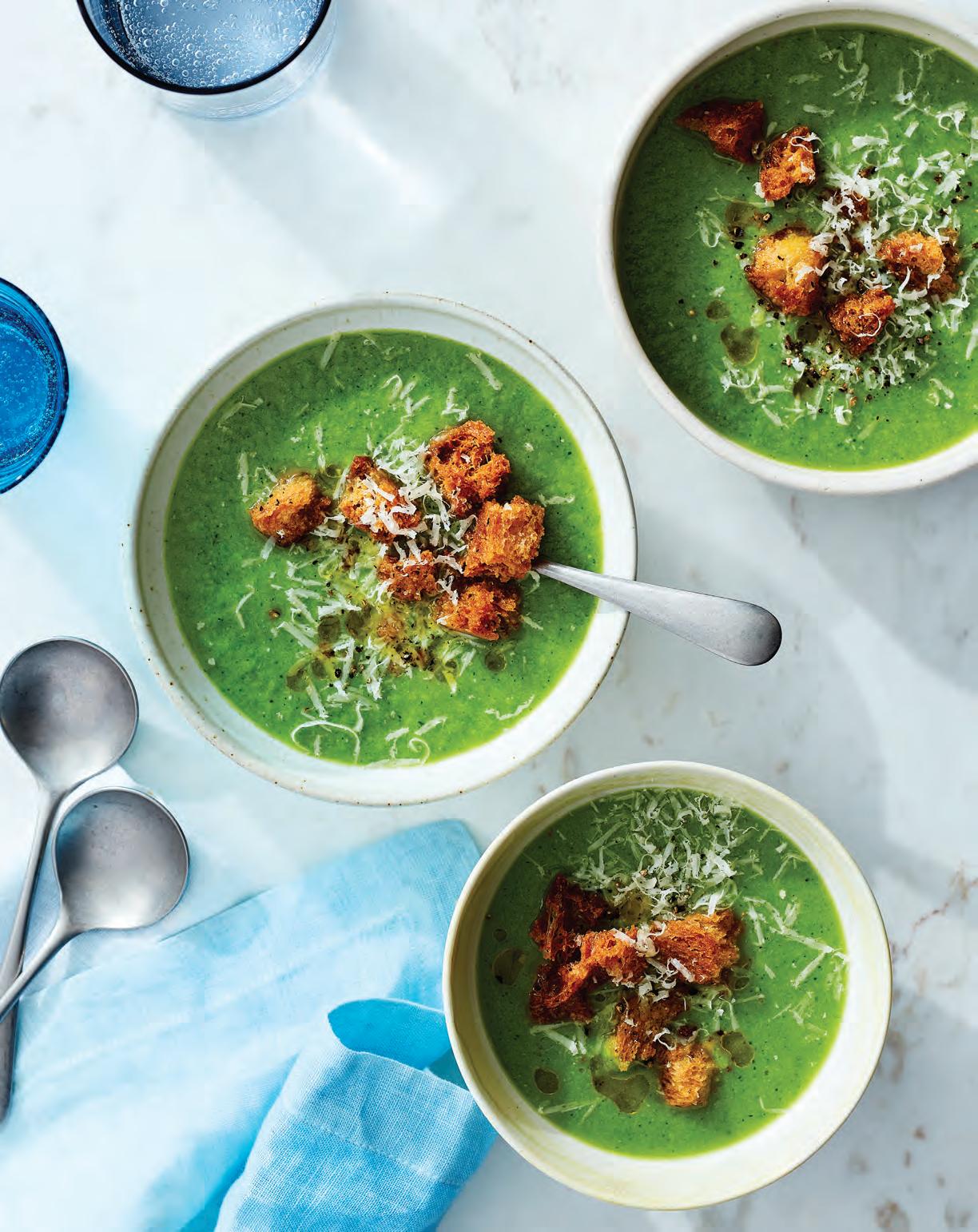


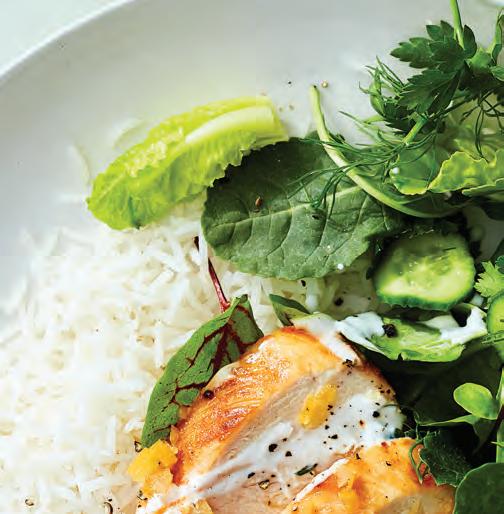
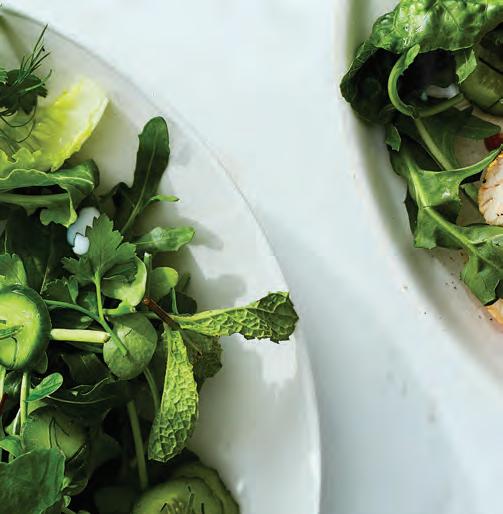
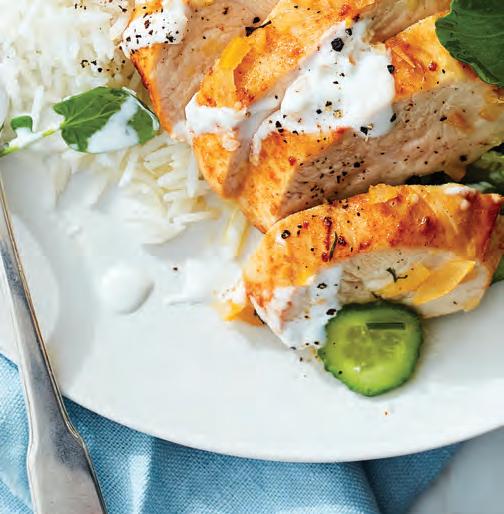

frozen broccoli and peas work here, making this a great allweather classic. (Bonus: Frozen veggies will save you a bit of prep time and also keep the color a bright, punchy green.)
Prep time: 5 minutes Total time: 30 minutes Serves: 4 (about 6 cups) 3½ cups chicken broth or vegetable stock 10 oz fresh or frozen peas 1 medium head broccoli, cut in florets (about 4 cups), fresh or frozen 1 small head fennel, trimmed and quartered (optional) ¼ teaspoon fine sea salt Freshly ground black pepper Yogurt, croutons, or freshly grated cheddar or
Parmesan cheese, for serving 1 tablespoon extra-virgin olive oil, for serving
1 Combine broth, peas, broccoli, and fennel in electric pressure cooker and seal. Cook on the steam setting or high pressure for 1 to 2 minutes. Release the steam manually.
2 2 Open the lid and remove the inner pot from the cooker. Use an immersion blender (or transfer the soup to a blender in batches) to process until smooth, about 3 minutes. Return to the pot on the Keep Warm setting until you’re ready to serve.
3 Ladle soup into bowls. Top with pepper, croutons, yogurt, or cheese. Drizzle with finishing oil. Serve warm.
Air Fryer
WHY TRY IT If you count chicken fingers, french fries, hush puppies, and empanadas among your fried food weaknesses, this modern gadget might be for you. Sure, it takes up a bit of counter space, but frying up your favorites with air instead of in a deep-fat fryer has major health advantages, not to mention it’s easier on cleanup.
HOW TO BUY IT Air fryer brands—and prices—run the gamut, from futuristic to simple and sleek. At the top of the spectrum, Philips offers a multicooking, high-capacity model (with a price tag to match; these start around $250). For the most compact version, check out the Dash Tasti Crisp Electric Air Fryer for $60, or go for the middle ground with Instant Pot’s Duo Crisp 8-quart Pressure Cooker, Air Fryer, Dehydrator, and Roaster ($200), which does it all, from an easy-cleanup roast chicken, to french fries and dried apple rings, making it easy to commit to homemade and home-cooked, no matter what type of food you crave.
Fried Paprika Chicken with Lemons
This breezy, Mediterranean chicken is a dinner dream, with the easiest hands-on prep time and almost zero cleanup. The breast meat remains juicy and deeply flavored, without dealing with bones, brines, or even the grill.
Preserved lemons for the chopped lemon and juice offer a more nuanced flavor, but regular fresh lemon and lemon juice are still delicious. To make it a meal, serve the chicken sliced over salad or rice, with cucumber salad and plain, full-fat yogurt for drizzling or dipping.
Prep time: 10 minutes Cook time: 20 minutes Serves: 2 ½ lemon, roughly chopped ½ cup lemon juice, divided 2 tablespoons olive oil, divided
¾ teaspoon sweet or smoked paprika 2 boneless, skinless chicken breasts 1 hothouse or English cucumber ¼ teaspoon salt Freshly cracked black pepper 1 heaping tablespoon chopped fresh dill Cooked rice or toasted naan, for serving Plain, full-fat yogurt, stirred, for serving
1 Combine the chopped lemon with ¼ cup of the lemon juice and 1 tablespoon of olive oil in a zip-top bag or stainless steel bowl. Add the paprika and chicken breasts, toss to coat, and seal or cover. Set aside at room temperature for 10 minutes.
2 Cook the chicken in your air fryer at 400 degrees F until the chicken is plump and cooked through, 18 to 20 minutes.
3 Meanwhile, thinly slice the cucumber. Toss in a bowl with the remaining lemon juice and olive oil. Season with salt and pepper and then toss with the dill. Set aside. 4 Serve the chicken sliced over salad or rice, with cucumber salad, toasted naan, and a few tablespoons of yogurt for drizzling or dipping.
Bursting with Berries Morning Shake
Adapted from Every Day Is Saturday, by Sarah Copeland (Chronicle Books)
NutriBullet
WHY TRY IT The NutriBullet processes high-fiber, nutrientdense foods into shakes and smoothies in a flash. Its modest size and price tag make it a no-brainer investment. With names like The Nutrient Extractor, the benefit of this style blender is that you ingest all of the food—pulp, fiber, nutrients, and water from all manner of fruits and vegetables—all at once. Add in your favorite greens, fresh lemon juice for brightness, half a banana, pear, or apple for that just sweet enough balance and this becomes an easy daily habit.
HOW TO BUY IT NutriBullet’s compact ($50) and full-size ($100) blenders are both considerably more affordable than pro-level Vitamix and Blendtec, which are intended to blend dozens of smoothies a week, or even a day. If you’re doing green juice for one or two people in the morning, this sleek option can get the job done every time. Here’s a simple, repeatable breakfast shake that you can count on for delivering big on antioxidant-boosting berries along with probiotic-rich yogurt. If you want to keep it bright pink, make it as is—but if you don’t mind muting the color a bit, add in a handful of baby spinach or kale to pack in extra fiber, beta-carotene, and vitamin K. (You’ll see it, but not taste it—promise!)
Serves: 2 (makes 2 ½ cups) ½ frozen banana 1 cup frozen raspberries or strawberries 1 cup whole milk, oat milk, or nut milk ½ cup plain yogurt Splash pure vanilla extract 1 teaspoon honey or maple syrup ½ cup baby spinach or kale (optional)
1 Blend the banana, berries, milk, yogurt, vanilla, honey or syrup, and greens (if you’re using) until completely smooth and frothy; pour into a chilled glass, and enjoy.







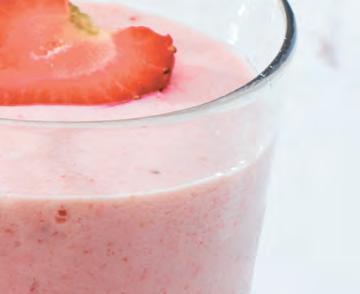

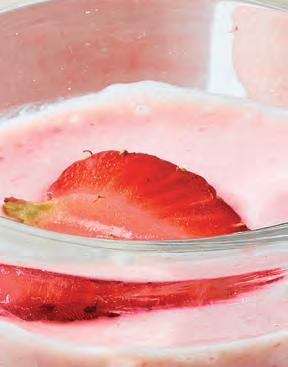
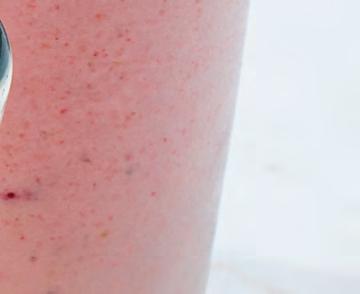

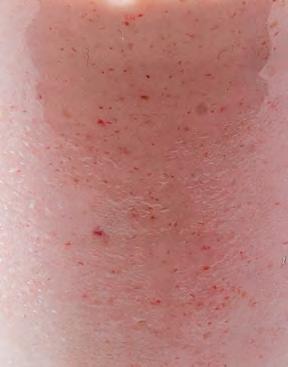
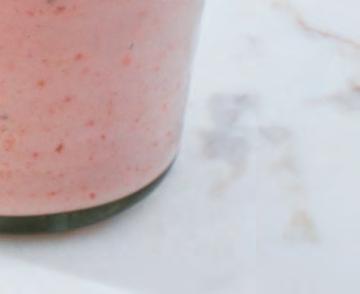

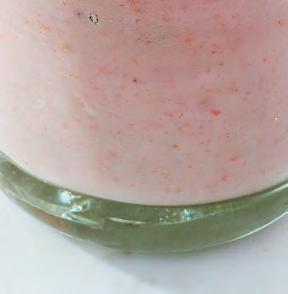

In Season: Allergies
How to prevent allergy issues—and how seasonal triggers interact with other lung conditions. BY GILLIAN SCOTT
Seasonal pollen from flowers, trees, grasses, and other plants causes many of us to sniffle and sneeze. Allergies can also lead to symptoms in your lungs, which can aggravate existing breathing conditions.
Sophia Chang, MD, MPH, internist, and Chief Clinical Informatics Officer for Clover Health, says seasonal allergies are the most common cause of nasal congestion and minor upperrespiratory issues in the spring and summer.
“Self-care at home is fine for nasal congestion and teary eyes,” Dr. Chang says, noting that neti pots and over-the-counter nondrowsy antihistamines are often helpful. “However, if you start having actual breathing problems—if you’re feeling short of breath or having difficulty catching your breath—it’s important to see your primary care doctor sooner rather than later.”
Signs you’re having serious breathing problems may include difficulty speaking a full sentence and getting more winded than you usually do walking up steps.
For many older adults, treating seasonal allergies takes a back seat to managing more serious chronic conditions. And that can be a problem, says Kumar Dharmarajan, MD, MBA, cardiologist, geriatrician, and Chief Scientific Officer at Clover Health.
“Some allergy symptoms may actually exacerbate chronic respiratory conditions common in older adults (including COPD and asthma) and shouldn’t be ignored,” explains Dr. Dharmarajan..
RESOURCES


The American Lung Association (ALA) offers support for people with chronic lung conditions, including: • A Better Breathers Club for people to discuss ways to cope with lung disease and provide support • The ALA also has a free Lung Help Line staffed with lung health professionals who can help answer questions about lung health. Call 1-800-LUNGUSA or visit lung.org/help-support. ➜




ALLERGIES AND COPD
WHAT IT IS:
COPD stands for chronic obstructive pulmonary disease. It’s a long-term disease that makes it hard to breathe. COPD is also used to refer to emphysema and chronic bronchitis.
WHAT TO DO:
COPD can be managed with medication, oxygen therapy, and pulmonary rehabilitation. The Lung Health Institute reports that people with COPD may find their symptoms worsen during allergy season, when they are at greater risk for flare-ups. “Tree, grass, and weed pollen and mold spores can increase COPD symptoms because exposure to an allergen typically narrows the airways and increases mucus production— making it even more difficult to breathe,” the institute explains. As with asthma, developing an action plan with your doctor can help you manage symptoms.
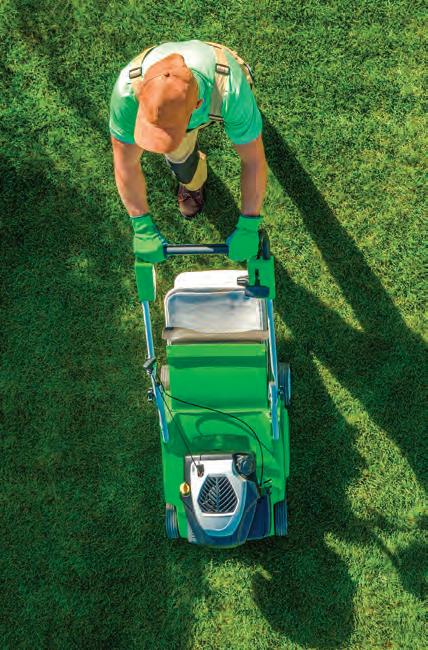
STEPS TO PREVENT BREATHING PROBLEMS
1. SHUT YOUR WINDOWS
Keep the windows of your home closed to help stop irritants like pollen from entering and sticking around on your furniture and bedding. The Centers for Disease Control and Prevention (CDC) recommends using fans and air conditioners to keep your home at a comfortable temperature during warmer months.
2. CLEAN THE AIR
The CDC says portable air filters can help clean irritants from the air. A high-efficiency particulate air (HEPA) filter, which is at least 99.97 percent effective at capturing particles 0.3 microns in size, can remove airborne particles like dust, pollen, mold, and bacteria. Just be sure to change filters regularly.
3. CHECK AIR QUALITY
“Most local weather reports track levels of allergens in the air,” notes Dr. Dharmarajan. “There are also several mobile apps that track pollen counts digitally.” When pollen counts are high, limit your exposure by staying inside. If you must go out, wear glasses to protect your eyes from pollen. Consider wearing a mask to avoid breathing in irritants.
4. TAKE EXTRA CARE WITH YARD WORK
Activities like weeding, raking, and mowing stir up allergens. The American Lung Association (ALA) recommends doing yard work in the early morning or evening, when pollen counts are lower.

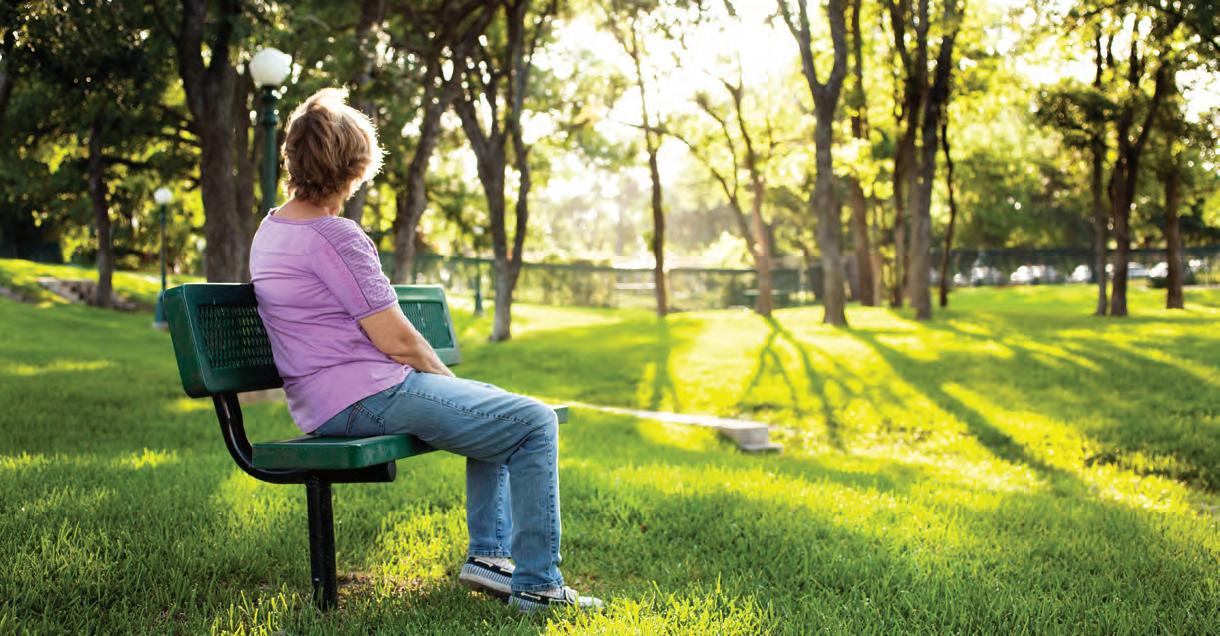
5. KEEP IT CLEAN
Do your laundry regularly, especially anything you’ve worn outside, suggests Dr. Dharmarajan. “Your clothes could be covered with pollen,” he says. “Avoid drying laundry outside on the line, as clothes can collect allergens.”
6. SEE YOUR DOCTOR
If you suspect your symptoms are due to seasonal allergies, call your doctor, says Dr. Dharmarajan. “Physicians sometimes miss allergy symptoms in seniors, particularly when they’re focused on larger health issues, so be sure to speak up.”
It’s also a good idea to consult your doctor before using over-the-counter medications—especially if you’re already taking five or more prescriptions per day.
“Antihistamines in particular can be dangerous to seniors, with common side effects including drowsiness and dizziness,” Dr. Dharmarajan explains.
ALLERGIES AND COVID-19
WHAT IT IS: COVID-19 cases range from mild to severe, with older adults and those with underlying conditions—including lung disease—at higher risk for complications. So far, says the CDC, there’s no sign that having allergies makes you more likely to get COVID-19. WHAT TO DO: If you have symptoms and think you may have been exposed to COVID-19, call your physician. Call 911 if you have trouble breathing, have pain in your chest, have trouble staying awake, or your lips and face start to turn blue.
ALLERGIES AND ASTHMA
WHAT IT IS: Asthma is a chronic condition in which the airways become swollen in response to an irritant, making it harder for air to move in and out of your body. WHAT TO DO: It’s important for people with asthma to know their triggers and have a plan to prevent, manage, and treat symptoms. An effective asthma treatment program helps you avoid severe attacks and trips to the emergency room. Work with your doctor to create an asthma action plan, which explains when to take medication, when to call your physician, and when to seek emergency care.


